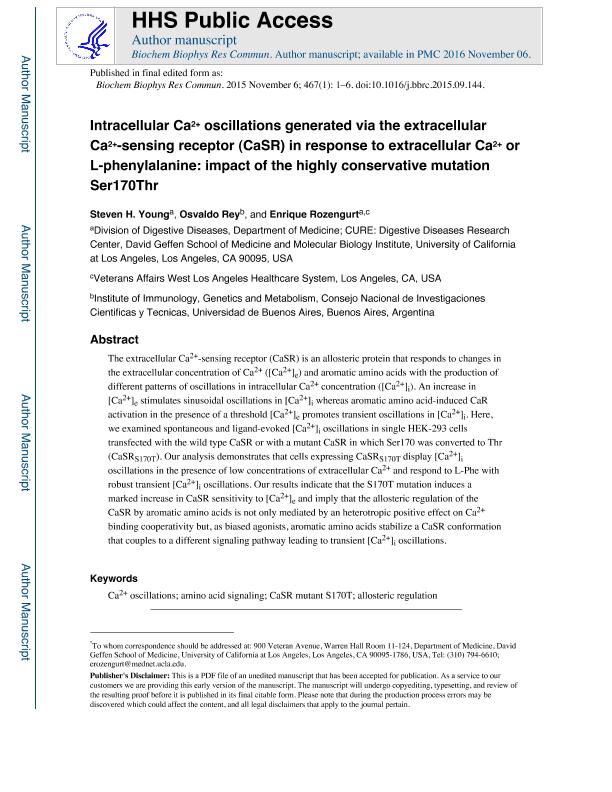Artículo
Intracellular Ca2+ oscillations generated via the extracellular Ca2+-sensing receptor (CaSR) in response to extracellular Ca2+ or l-phenylalanine: Impact of the highly conservative mutation Ser170Thr
Fecha de publicación:
11/2015
Editorial:
Academic Press Inc Elsevier Science
Revista:
Biochemical and Biophysical Research Communications
ISSN:
0006-291X
Idioma:
Inglés
Tipo de recurso:
Artículo publicado
Clasificación temática:
Resumen
The extracellular Ca2+-sensing receptor (CaSR) is an allosteric protein that responds to changes in the extracellular concentration of Ca2+ ([Ca2+]e) and aromatic amino acids with the production of different patterns of oscillations in intracellular Ca2+ concentration ([Ca2+]i). An increase in [Ca2+]e stimulates sinusoidal oscillations in [Ca2+]i whereas aromatic amino acid-induced CaR activation in the presence of a threshold [Ca2+]e promotes transient oscillations in [Ca2+]i. Here, we examined spontaneous and ligand-evoked [Ca2+]i oscillations in single HEK-293 cells transfected with the wild type CaSR or with a mutant CaSR in which Ser170 was converted to Thr (CaSRS170T). Our analysis demonstrates that cells expressing CaSRS170T display [Ca2+]i oscillations in the presence of low concentrations of extracellular Ca2+ and respond to L-Phe with robust transient [Ca2+]i oscillations. Our results indicate that the S170T mutation induces a marked increase in CaSR sensitivity to [Ca2+]e and imply that the allosteric regulation of the CaSR by aromatic amino acids is not only mediated by an heterotropic positive effect on Ca2+ binding cooperativity but, as biased agonists, aromatic amino acids stabilize a CaSR conformation that couples to a different signaling pathway leading to transient [Ca2+]i oscillations.
Palabras clave:
Calcium sensing receptor
,
GPCR
,
Calcium oscillations
,
signal transduction
Archivos asociados
Licencia
Identificadores
Colecciones
Articulos(INIGEM)
Articulos de INSTITUTO DE INMUNOLOGIA, GENETICA Y METABOLISMO
Articulos de INSTITUTO DE INMUNOLOGIA, GENETICA Y METABOLISMO
Citación
Young, Steven H.; Rey, Osvaldo; Rozengurt, Enrique; Intracellular Ca2+ oscillations generated via the extracellular Ca2+-sensing receptor (CaSR) in response to extracellular Ca2+ or l-phenylalanine: Impact of the highly conservative mutation Ser170Thr; Academic Press Inc Elsevier Science; Biochemical and Biophysical Research Communications; 467; 1; 11-2015; 1-6
Compartir
Altmétricas




